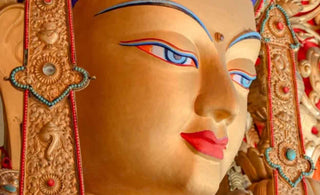
The meticulous application of gold leaf to Tibetan statues, often referred to as gilding, is an art form that transcends the physical and ventures into the realm of the divine. This ancient technique involves the delicate placement of gold leaf or gold powder onto the surface of statues, transforming them into resplendent embodiments of spiritual grace. The process itself is a testament to the artisan's skill, patience, and a deep understanding of both the material and the spiritual significance of gold.
Consider a 15th-century Tibetan statue of Green Tara, a revered bodhisattva associated with compassion and enlightened activity. In the skilled hands of a master gilder, each crevice and contour of the statue becomes a canvas awaiting the ethereal touch of gold. The artisan meticulously prepares the surface, ensuring it is smooth and receptive to the transformative embrace of this precious metal. The gold leaf, often as thin as one micron, is delicately applied using a brush made from the softest squirrel hair.
The symbolism behind gilding goes beyond mere aesthetics. Gold, in Buddhist philosophy, represents purity and enlightenment. The application of gold leaf to the statue is akin to an act of reverence, elevating the ordinary into the extraordinary, the mundane into the sacred.
When applied to a statue, such as the venerable 15th-century depiction of Green Tara, a bodhisattva revered for compassion and enlightened activity, the act becomes a sublime expression of reverence. In the skilled hands of a master artisan, each nuance of the statue is meticulously prepared to receive the ethereal touch of gold. The very essence of Green Tara, with her compassionate gaze and dynamic pose, becomes a canvas for the transformative power of this precious metal.
As the delicate gold leaf adheres to the surface, it marks not only a physical transformation but a spiritual elevation. The ordinary stone or metal of the statue is metamorphosed into an extraordinary vessel, embodying the sacred teachings of Buddhism. Green Tara, traditionally associated with swift and compassionate action, takes on a new radiance as the gold leaf captures and reflects the inner illumination intrinsic to her enlightened nature. The symbolism extends beyond the visual realm; it encapsulates the aspirations of the devotees and the spiritual journey towards enlightenment.
The process of gilding, in this context, becomes a sacred dialogue between the material and the divine—a union where craftsmanship and spirituality converge. Each stroke of the artisan's brush, delicately applying the gold leaf, is an act of devotion. The act mirrors the Buddhist path itself, where the mundane aspects of life are elevated to sacred significance through mindful intention and practice. The gilded Green Tara, with her golden adornments, becomes a living testament to the interplay of the human and the divine, a tangible representation of the transcendence of the ordinary into the realm of the sacred.
The symbolism of gilding extends far beyond the surface of Tibetan statues. It is an intricate dance between materials and meanings, a sacred alchemy that transforms the physical into the spiritual. As the statue begins to don its golden attire, it not only reflects the external illumination but also captures the inner radiance associated with the Buddha's teachings.
The process itself is steeped in tradition, with artisans following age-old techniques passed down through generations. The gold leaf, meticulously sourced and often hand-beaten into delicate sheets, holds a spiritual charge, embodying the collective aspirations for enlightenment. The act of gilding becomes a meditation, a sacred dance between the artisan, the statue, and the divine essence it represents.
However, the art of gilding is not without its challenges. The sheer delicacy of gold leaf makes it susceptible to even the gentlest breeze or the subtlest breath. Artisans need to work in controlled environments to minimize disturbances. Additionally, the choice of adhesive plays a crucial role; a blend of traditional glues, such as rabbit skin glue, and contemporary alternatives are employed to ensure a lasting bond between gold and statue.
The transformative power of gilding is not only visual but also symbolic. It infuses the statue with a luminosity that transcends the material realm, hinting at the spiritual illumination inherent in Buddhist teachings. The play of light on the gilded surface becomes a dance, casting shadows that echo the intricate narratives engraved in the statue's form.
Conclusion
In conclusion, the art of applying gold leaf to Tibetan statues is a venerable tradition that marries craftsmanship with spirituality. Each stroke of the artisan's brush, each delicate application of gold leaf, is a prayer in motion—a gesture that seeks to capture the divine essence within the material form. The gilded statue, whether depicting a bodhisattva, a Buddha, or a deity, becomes a beacon of enlightenment, inviting contemplation and devotion. It stands as a testament to the harmonious marriage of artistry and spirituality, where the radiance of gold mirrors the inner luminosity that resides within all beings on their path to enlightenment.























